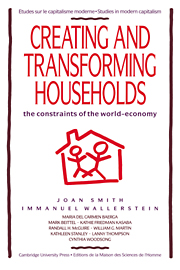Book contents
- Frontmatter
- Contents
- Preface
- I INTRODUCTION
- II THE UNITED STATES
- Introduction
- 1 The Detroit story: the crucible of Fordism
- 2 New York City: the underside of the world's capital
- 3 Binghamton: the secrets of a backwater
- 4 Puerto Rico: from colony to colony
- III MEXICO
- IV SOUTHERN AFRICA
- V CONCLUSION
- A postscript on method
- References
- Index
- Studies in Modern Capitalism
2 - New York City: the underside of the world's capital
Published online by Cambridge University Press: 07 June 2010
- Frontmatter
- Contents
- Preface
- I INTRODUCTION
- II THE UNITED STATES
- Introduction
- 1 The Detroit story: the crucible of Fordism
- 2 New York City: the underside of the world's capital
- 3 Binghamton: the secrets of a backwater
- 4 Puerto Rico: from colony to colony
- III MEXICO
- IV SOUTHERN AFRICA
- V CONCLUSION
- A postscript on method
- References
- Index
- Studies in Modern Capitalism
Summary
A century ago New York City, the “economic capital” of a new core area in the world-economy, candidate for future “world capital,” still attracted low-wage laborers and petty entrepreneurs from all over Europe, many of them from peasant backgrounds. After the Second World War, the region became one of the highest-wage areas in the world-economy, its steady rise marking the hegemonic position of the United States in the world-system. Yet, by the close of the 1970s, New York City had once again become dependent upon low-wage immigrant populations for its prosperity. The “new” immigrants from Asia, the Caribbean, and Latin America, who labored in sweatshops and small family businesses, now complemented the high-salaried professionals found in global corporate and finance centers headquartered in the city (Portes and Sassen-Koob, 1987). Economic life in New York City seems to have come full circle over the past hundred years.
By 1890, more than half of New York City's population (age 10 and older) had been incorporated into the labor force, most on an irregular or seasonal basis, or for only parts of their lifetime. Men comprised nearly 74 percent of the wage earners. Nearly 40 percent of these were employed in manufacture, mostly of consumer goods; 29 percent were engaged in trade and transportation; and 26 percent in domestic and personal service (USBC, 1890a, in: 570—71). The expansion of the manufacturing labor force was not the result of the emergence of a group of industrial giants, as in Detroit.
- Type
- Chapter
- Information
- Creating and Transforming HouseholdsThe Constraints of the World-Economy, pp. 63 - 90Publisher: Cambridge University PressPrint publication year: 1992



